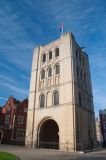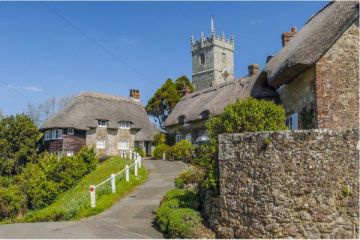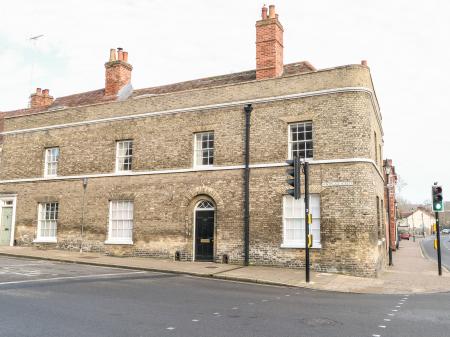
There's a lot of history packed into a small area in the centre of historic Bury St Edmunds. Here's an overview of the major historic attractions. Note that the local visitor centre website has a town centre map of places to visit which is very useful for walking tours. Walking is definitely the best way to see the town, as the major historic buildings are located so close together that you could easily visit most within a few leisurely hours.
St Edmundsbury Cathedral
In a county with so many wonderful historic churches, this is the only cathedral. Originally a 15th century church, it was raised to cathedral status in the 20th century.
Abbey Gate (photo)
This delightful medieval relic stands at the entrance to Abbey Gardens. The original abbey gates were destroyed in 1327 when irate townsfolk rioted against the power of the monks. The new Abbey Gate (or Great Gate) was built about 20 years later as a grand entrance to the abbey grounds, a function it still fulfils today.
Abbey Gardens (photo)
This attractive park and garden space occupies the site of the medieval abbey of St Edmundsbury. The abbey ruins are dotted around the park.
Bury St Edmunds Abbey
Once one of the most powerful and influential monasteries in England, the abbey housed the relics of Edmund, King and Martyr, the original patron saint of England.
St Maryâs Church
One of the largest parish churches in Suffolk, perhaps the entire country. Near the high altar is the tomb of Mary Tudor, sister of Henry VIII
The Norman Tower (photo)
This extremely attractive 12th century tower stands directly south of the cathedral, on Angel Hill. It dates from 1120, and acts as the bell tower for the cathedral. Nearby is the Martyrs Memorial, a monument to 17 Protestants put to death under Mary I's brief and unsuccessful attempts to stop the course of the English Reformation.
The Great Churchyard (photo)
This large open space extends between the cathedral precinct and St Mary's church. Within the cemetery stands a ruined charnel house, and all about the space are dotted historic monuments. Perhaps the most notable monument is to Martha Gosnold, whose father named Marthaâs Vineyard, Massachusetts, in her honour
Victorian Corn Exchange (photo)
This elegant building, with its lovely Grecian portico and classical columns, was built as a merchant centre in 1862.
Moyses Hall Museum
Probably the oldest building in Bury St Edmunds, the Hall dates to 1180 and now houses a museum of local history. The Hall is one of the oldest domestic buildings in England, and has served as a police station, gaol, inn, and dwelling.
Smiths Row - Bury St Edmunds Art Gallery photo
This elegant building on the Maket Place was designed by Robert Adam. It now houses a busy art gallery and shops. external link
The Theatre Royal
The only complete Regency theatre to survive in England - a beautiful, elegant building, open for guided tours.
Greene King Brewery Museum
There has been a brewery on this site since at least 1700. Learn about the brewing process and taste the results.
Suffolk Regiment Museum
Covering the rich history of the Regiment from its origination in 1685.
The Guildhall
The oldest complete civic building in England. Now restored and open for guided tours. external link
The Nutshell (photo)
Not precisely an historic building, but of interest nonetheless - the Nutshell is the smallest pub in Britain. external link
WH Smith building, Cornhill (photo)
This lovely old timber framed is interesting for its wonderful pargeting, a form of decorative plasterwork often seen on late medieval buildings in Suffolk. The top panel illustrates the legend of King Canute telling the tide to stop. Its an appropriate subject for a Bury building, as it was Canute who founded the monastery here around 1020, to serve as home to the shrine of St Edmund.
The Athenaeum (photo)
Just opposite the cathedral stands this elegant building, established as an Assembly Hall in the 18th century. Charles Dickens gave several public readings here, and it still serves as a public function venue. (external link)
Angel Hotel (photo)
Almost beside the Athenaeum, the Angel has stood opposite the cathedral for hundreds of years. Dickens stayed here, as did his fictional hero, Samuel Pickwick, in the Pickwick Papers.
These are just the highlights among historic buildings you can see in Bury. Most are close enough that you can simply stroll around the town centre. Enjoy!
In a county with so many wonderful historic churches, this is the only cathedral. Originally a 15th century church, it was raised to cathedral status in the 20th century.
Abbey Gate (photo)
This delightful medieval relic stands at the entrance to Abbey Gardens. The original abbey gates were destroyed in 1327 when irate townsfolk rioted against the power of the monks. The new Abbey Gate (or Great Gate) was built about 20 years later as a grand entrance to the abbey grounds, a function it still fulfils today.
Abbey Gardens (photo)
This attractive park and garden space occupies the site of the medieval abbey of St Edmundsbury. The abbey ruins are dotted around the park.
Bury St Edmunds Abbey
Once one of the most powerful and influential monasteries in England, the abbey housed the relics of Edmund, King and Martyr, the original patron saint of England.
St Maryâs Church
One of the largest parish churches in Suffolk, perhaps the entire country. Near the high altar is the tomb of Mary Tudor, sister of Henry VIII
The Norman Tower (photo)
This extremely attractive 12th century tower stands directly south of the cathedral, on Angel Hill. It dates from 1120, and acts as the bell tower for the cathedral. Nearby is the Martyrs Memorial, a monument to 17 Protestants put to death under Mary I's brief and unsuccessful attempts to stop the course of the English Reformation.
The Great Churchyard (photo)
This large open space extends between the cathedral precinct and St Mary's church. Within the cemetery stands a ruined charnel house, and all about the space are dotted historic monuments. Perhaps the most notable monument is to Martha Gosnold, whose father named Marthaâs Vineyard, Massachusetts, in her honour
Victorian Corn Exchange (photo)
This elegant building, with its lovely Grecian portico and classical columns, was built as a merchant centre in 1862.
Moyses Hall Museum
Probably the oldest building in Bury St Edmunds, the Hall dates to 1180 and now houses a museum of local history. The Hall is one of the oldest domestic buildings in England, and has served as a police station, gaol, inn, and dwelling.
Smiths Row - Bury St Edmunds Art Gallery photo
This elegant building on the Maket Place was designed by Robert Adam. It now houses a busy art gallery and shops. external link
The Theatre Royal
The only complete Regency theatre to survive in England - a beautiful, elegant building, open for guided tours.
Greene King Brewery Museum
There has been a brewery on this site since at least 1700. Learn about the brewing process and taste the results.
Suffolk Regiment Museum
Covering the rich history of the Regiment from its origination in 1685.
The Guildhall
The oldest complete civic building in England. Now restored and open for guided tours. external link
The Nutshell (photo)
Not precisely an historic building, but of interest nonetheless - the Nutshell is the smallest pub in Britain. external link
WH Smith building, Cornhill (photo)
This lovely old timber framed is interesting for its wonderful pargeting, a form of decorative plasterwork often seen on late medieval buildings in Suffolk. The top panel illustrates the legend of King Canute telling the tide to stop. Its an appropriate subject for a Bury building, as it was Canute who founded the monastery here around 1020, to serve as home to the shrine of St Edmund.
The Athenaeum (photo)
Just opposite the cathedral stands this elegant building, established as an Assembly Hall in the 18th century. Charles Dickens gave several public readings here, and it still serves as a public function venue. (external link)
Angel Hotel (photo)
Almost beside the Athenaeum, the Angel has stood opposite the cathedral for hundreds of years. Dickens stayed here, as did his fictional hero, Samuel Pickwick, in the Pickwick Papers.
These are just the highlights among historic buildings you can see in Bury. Most are close enough that you can simply stroll around the town centre. Enjoy!

